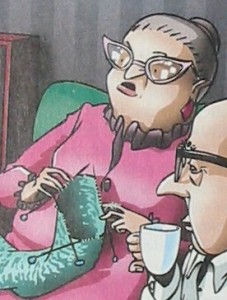Oblique Socks: Skew
Eigentlich dachte ich ja, so schnell würde ich keine Socken mehr stricken, weil es doch langweilig geworden war. Aber dann kam Skew. Und die mußte ich ausprobieren.
I’d thought I wouldn’t knit more socks soon because it was about getting boring. But the came Skew. And I had to try.
 Allerdings ist die Socke nicht so leicht an den Fuß anzupassen. Und die Maschenprobe bekam ich nicht passend. Wie üblich, entweder die Länge oder die Breite. (Und das auch nur mit 1,75er Nadeln, wobei die Anleitung nach 2,25 verlangt…) Also habe ich die erste Variante strickt nach Anleitung gestrickt. (Als Garn hatte ich Noro Kureyon.)
Allerdings ist die Socke nicht so leicht an den Fuß anzupassen. Und die Maschenprobe bekam ich nicht passend. Wie üblich, entweder die Länge oder die Breite. (Und das auch nur mit 1,75er Nadeln, wobei die Anleitung nach 2,25 verlangt…) Also habe ich die erste Variante strickt nach Anleitung gestrickt. (Als Garn hatte ich Noro Kureyon.)
Das Ergebnis war gelinde gesagt seltsam…
Die Spitze absurd spitzig, das Fußteil zu lang und mit dem Abnahmen am Bein hätte ich die Socke gar nicht mehr über die Ferse bekommen. Zumal die Socke ja durch den schrägen Maschenverlauf eh schon weniger dehnbar ist. (Warum zuerst so viele Maschen abgenommen werden, damit man dann wieder welche zunimmt, um das Bündchen zu stricken… das verstehe ich definitiv nicht.)
As usual I was not able to match the gauge (either stitches or rows) so fitting the sock was not easy. (The pattern calls for 2.25 mm needles, I needed 1.75 mm.) So I’ve knitted one sock according to the pattern. (My yarn was Noro Kureyon Sock.)
The result was a bit… odd.
The toe was absurdly pointy and too long. So was the foot, too long. And the decreases for the leg made the sock so tight that I could hardly pull it over my heel. (Since the stitches run oblique they are less stretchy anyhow.) And what I do not understand is why there are all those decreases just to make increases for the cuff again…?
 Also habe ich die Socke wieder komplett aufgeribbelt und einen neuen Versuch gestartet. Das Garn mochte das nicht so gerne, es ist ohnehin nicht sehr fest gedreht und unregelmäßig und das wird durchs Aufziehen und neu verstricken nicht besser. (Die Farben sind absolut toll, aber was der Hype um Noro so soll ist mir nach der Erfahrung nicht ganz klar.)
Also habe ich die Socke wieder komplett aufgeribbelt und einen neuen Versuch gestartet. Das Garn mochte das nicht so gerne, es ist ohnehin nicht sehr fest gedreht und unregelmäßig und das wird durchs Aufziehen und neu verstricken nicht besser. (Die Farben sind absolut toll, aber was der Hype um Noro so soll ist mir nach der Erfahrung nicht ganz klar.)
Die Zunahme an der Spitze verändert, den Fuß gekürzt und auch die Ferse. Letzteres war nicht ganz beabsichtigt, so ganz hatte ich das Muster noch nicht verstanden. Die ist also etwas eng. Und am Bein habe ich weniger abgenommen als laut Anleitung.
So I frogged it and made a new start. The yarn wasn’t well twisted and quite irregular from the beginning and this did not get better from frogging. (the colors are great but I cannot say that I really understand that Noro Hype.)
 So I changed the increases for the toe, shortened the foot and also the heel. That was not completely intended, I hadn’t really understood the pattern then. ‚So the heels are a bit tight. And I made less decreases for the leg, of course.
So I changed the increases for the toe, shortened the foot and also the heel. That was not completely intended, I hadn’t really understood the pattern then. ‚So the heels are a bit tight. And I made less decreases for the leg, of course.
Aber so passen sie. Zumindest vor der Wäsche. Denn Handwäsche für Socken ist keine Option, sie warten im Moment auf die Waschmaschine. Eingehen dürfen sie aber nicht mehr.
Die Farben sind übrigens auch etwas unerwartet, das Knäuel war so gewickelt, daß rot die dominierende Farbe erschien…
Spaß hat es auf alle Fälle gemacht, also wird es noch eine andere Version geben, diesmal aus bewährter Regia Wolle.
(Im Detail sind meine Veränderungen übrigens bei Ravelry beschrieben.)
But they fit, at least before washing. At the moment they are waiting for the washing machine, since handwash is not an option for sock wool. I hope they will not become any smaller…
The colors were a bit unexpected… The skein seemed to have red a the dominant color, so the amount of green was quite a surprise…
But knitting the socks was fun so there will be more of it. But the next version will be made of Regia.
(Detailed descriptions of my changes are on Ravelry.)













